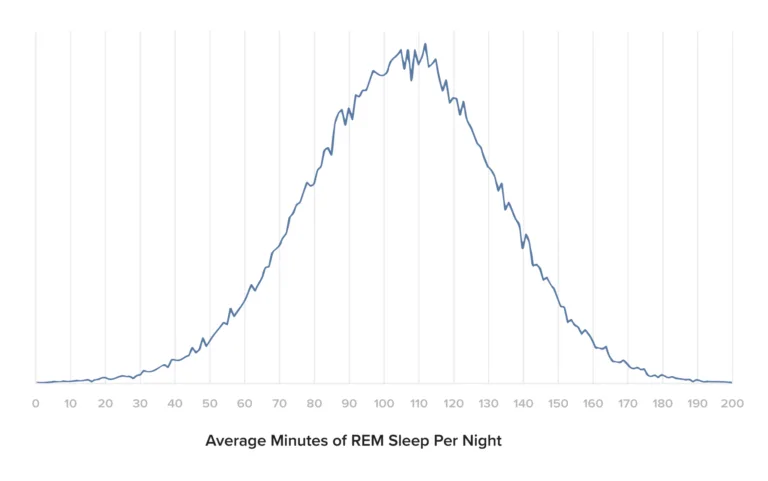Topics
- Article
- Sleep
Can You Get Too Much REM Sleep? Are You Getting Enough?

How Much REM Sleep Do You Need?
Rapid eye movement sleep, more commonly referred to as REM sleep, is one of 4 stages of sleep (also light, slow wave/deep, and wake) that your body spends time in each night. REM is the “mentally restorative” sleep stage during which your brain converts short-term memories made during the day into long-term ones. Getting enough REM sleep is an essential part of keeping your brain and body healthy and optimizing daily performance. So, how much REM sleep do we need? On average, for most adults it’s about 90 minutes per night. However, this can change for a variety of different reasons that we’ll dive into below.
What Does Typical REM Sleep Look Like?
While we’re asleep the human body goes through several sleep cycles (normally 3-5 per night). Within each cycle, the REM stage usually comes last, following light and deep sleep. Your first period of REM sleep is generally only a few minutes long. REM cycles then get longer as the night progresses, with the final one often lasting up to an hour. For healthy adults, 20-25% of your total time asleep should be REM sleep. That’s where the 90-minute number mentioned above comes from. If you sleep for 7-8 hours, 20% of that equates to roughly an hour-and-a-half, or 90 minutes. However, it’s worth noting that the amount of REM sleep we need also declines with age. With newborn babies, it can be 50% of their total sleep time. Sleep studies indicate that percentage drops significantly early on, then continues to decrease gradually as we get older. Read More: The Differences Between REM Sleep and Deep Sleep
How Much Time Should We Spend in Rem Sleep?
Below is a chart depicting the average nightly duration of REM sleep for all WHOOP members. The combined average is 105 minutes per night, while the middle 50% (25th-75th percentile) of people average between 87 and 124 minutes of REM each night. It’s important to mention that by nature WHOOP members tend to be interested in improving their sleep and overall well being, so it stands to reason that they may get more sleep (and in turn more REM sleep) than the general population.

A Chart showing The average amount of REM sleep WHOOP members get each night.
What Does Too Much REM Sleep Mean? Too Little?
Getting an unusually large amount of REM sleep in a given night is often an indication that you are sleep deprived. Your body routinely gets most of its REM sleep later in the night, during the final hours that you are asleep. If you wake up very early or don’t sleep as long as you normally do, you miss out on a disproportionate amount of REM. To make up for this, your body will adjust the following night and get more REM sleep at an earlier time. “A great sign that you likely did not get enough sleep last night is that you are getting REM sleep too early in the night [tonight].” - Podcast 55: How Sleep Impacts Performance For the most part, a sleep disorder or anything that hurts your sleep will generally negatively impact your REM sleep patterns as well. Consuming alcohol before going to bed is one thing that is particularly bad for REM. From another episode of the WHOOP Podcast: "Alcohol is a sedative, it’s not actually a sleeping aid. Sleep is an incredibly active process, our bodies are working really, really hard when we sleep, and if you have alcohol in your system, none of those very active processes can happen. ... If you think about your typical sleep cycle, you fall asleep, within a couple minutes you typically see your first slow-wave sleep episode, that’s the physically restorative part of sleep, when you’re sedated that just doesn’t happen at all. Alcohol actually disproportionately crushes REM sleep, the mentally restorative part of sleep. … You miss your first big REM episode, you miss a lot of slow-wave sleep, you just get a lot of light sleep. You don’t achieve what the point of sleep is actually.”
Track How Much REM Sleep You’re Getting With WHOOP
WHOOP accurately tracks your sleep in detail each night and tells you exactly how much time you spend in each stage of sleep, including REM. Additionally, the WHOOP app provides a Sleep Planner that recommends daily bed and wake times (based on your own personal circadian rhythm) to maximize the efficiency of your sleep and help ensure you’re getting all the REM sleep you need.

The WHOOP app displays your time in each stage of sleep, and too much REM may indicate you are sleep deprived.
Learn More: How Much Time Should You Spend in Each Stage of Sleep?